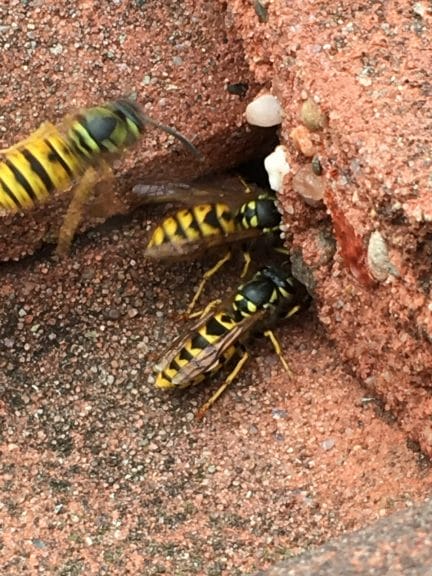Updated on 08/04/2025
Like most insects, wasps go through a series of stages before they become the adult wasps that we all recognise.
When we carry out wasp nest treatments, we are often asked about the life cycle of a wasp. The wasp life cycle has a few key stages, which we will explain in detail in this post.
What Is The Life Cycle Of A Wasp?
The wasp life cycle is similar to that of bees, beginning with a single queen wasp, who will build a nest, lay eggs and start a wasp colony of worker wasps, which will begin life as larvae after their wasp eggs hatch.
The queen gathers sugary substances to feed the larvae, and they pupate and become adult worker wasps. Initially, the nest produces males and infertile female wasps, but later, it will produce fertile wasps to build the next nest. When they sexually mature, they will leave the nest and start mating to build a new nest. Old wasp nests die during the winter months, and the wasps will hibernate until the new wasp season.
The Queen Wasp Awakens
A single-mated queen emerges from hibernation in the early spring. She establishes her nesting site in a cavity. As she builds her nest, the cells are constructed, and she eventually lays eggs, one in each cell. Wasp nests are made from a combination of chewed wood pulp and wasp saliva. At this stage, the wasp nest is the size of a golf ball and looks like a large paper construction with a small nest entrance that looks like a little hole.

Her Offspring Emerge
About 30 days after the queen wasp starts looking after her young, her first offspring of adult worker wasps emerges. They are all sterile female wasps at this point. The workers take over the foraging, brood care and nest building and maintenance duties. The queen then stays in the nest, and her job is to lay eggs to build the colony.
The Larvae Hatch
After a few days, the larvae will hatch from the newest eggs. The adult workers bring insects back to the nest to feed to the hungry larvae, which offer a sugary food supply to the workers via a process called trophallaxis. The larvae grow over a couple of weeks before they spin their pupal cap and pupate.

The Colony Grows
Over the summer months, the colony will grow to include thousands of wasps, depending on the species. Initially, the wasp will be made up of sterile female worker wasps. Once the colony is big enough, the queen will switch to laying a sexual brood: these are fertile males and the sexual females capable of becoming next year’s queens.

Wasps Mature And Leave The Nest
When the sexual brood matures, they leave the wasp colony to mate. Wasps hibernate over winter and will find a safe, warm space to do that, such as a loft space or a warm area. After this stage, the nest has done its job. The workers are still alive with no brood to feed them. This is when they start to bother you.

What Happens If You Leave A Wasp Nest?
If you leave a wasp nest, it can become home to many other insects, such as bed bugs or ants. The wasp nest is made up of wood pulp, so any type of textile pest would be able to survive inside. In the past, Pest-Tech has dealt with carpet beetle infestations in a loft space. When we opened it up, the nest was loaded with the cases of wooly bears (carpet beetle larvae).
As such, it’s important that you get rid of the wasp nest quickly, even if it is empty. While most wasp nests stay empty, sometimes, old wasp nests function as shelter for other pests and can cause ongoing issues. Wasp nests start at the size of a golf ball, and the average wasp nest grows to the size of a basketball, but they can get even bigger and cause serious damage to the structure of your property.

How To Deal With A Wasp Colony Or Nest On Your Property
If you find a wasp nest, you need to be proactive. In the UK, you’re likely to find a common wasp nest, which might be built inside sheds, garages, your roof or even inside your chimney or wall cavities. Nest expansion is rapid, and it could become heavy and cause property damage.
Wasps can also become aggressive if they feel threatened, so you might get a painful sting. In some cases, you could be allergic to wasps, which could lead to painful welts or even anaphylactic shock.
That’s why you need to work with professional pest controllers like Pest-Tech to provide wasp control services. We carry out wasp nest removals and treatments to all homes and businesses in Maidstone and Kent. To discover more about wasps and understand how to get rid of a wasp nest, call our professional team at 01622 296055.
